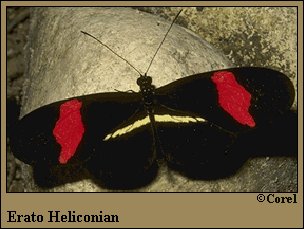 |
 

 |



Erato Heliconian (Heliconius erato [Linnaeus])
Wing span: 2 5/8 - 3 1/8 inches (6.7 - 8 cm).
Identification: Forewing black with pink-red band; hindwing black with yellow stripe.
Life history: Males patrol during the day for females, and also mate with females as they emerge from the chrysalis. After mating, males place a repellant chemical on the female's abdomen to keep other males from mating with her. Eggs are laid singly on young tendrils and shoots, which the caterpillars eat.
Flight: June and August-September in South Texas, all year in the tropics.
Caterpillar hosts: Various passion-vines (Passiflora species).
Adult food: Flower nectar and pollen.
Habitat: Tropical and subtropical forests and edges.
Range: Brazil north through Central America to Mexico; a rare stray to South Texas.
Conservation: Not required for rare stray.
The Nature Conservancy Global Rank: G5 - Demonstrably secure globally, though it may be quite rare in parts of its range, especially at the periphery.
Management needs: None reported.
References:
Opler, P. A. and V. Malikul. 1992. A field guide to eastern butterflies. Peterson
field guide #4. Houghton-Mifflin Co., Boston. 396 pages, 48 color plates.
Scott, J. A. 1986. The butterflies of North America. Stanford University Press,
Stanford, Calif. 583 pages, 64 color plates.
Author: Jane M. Struttmann

